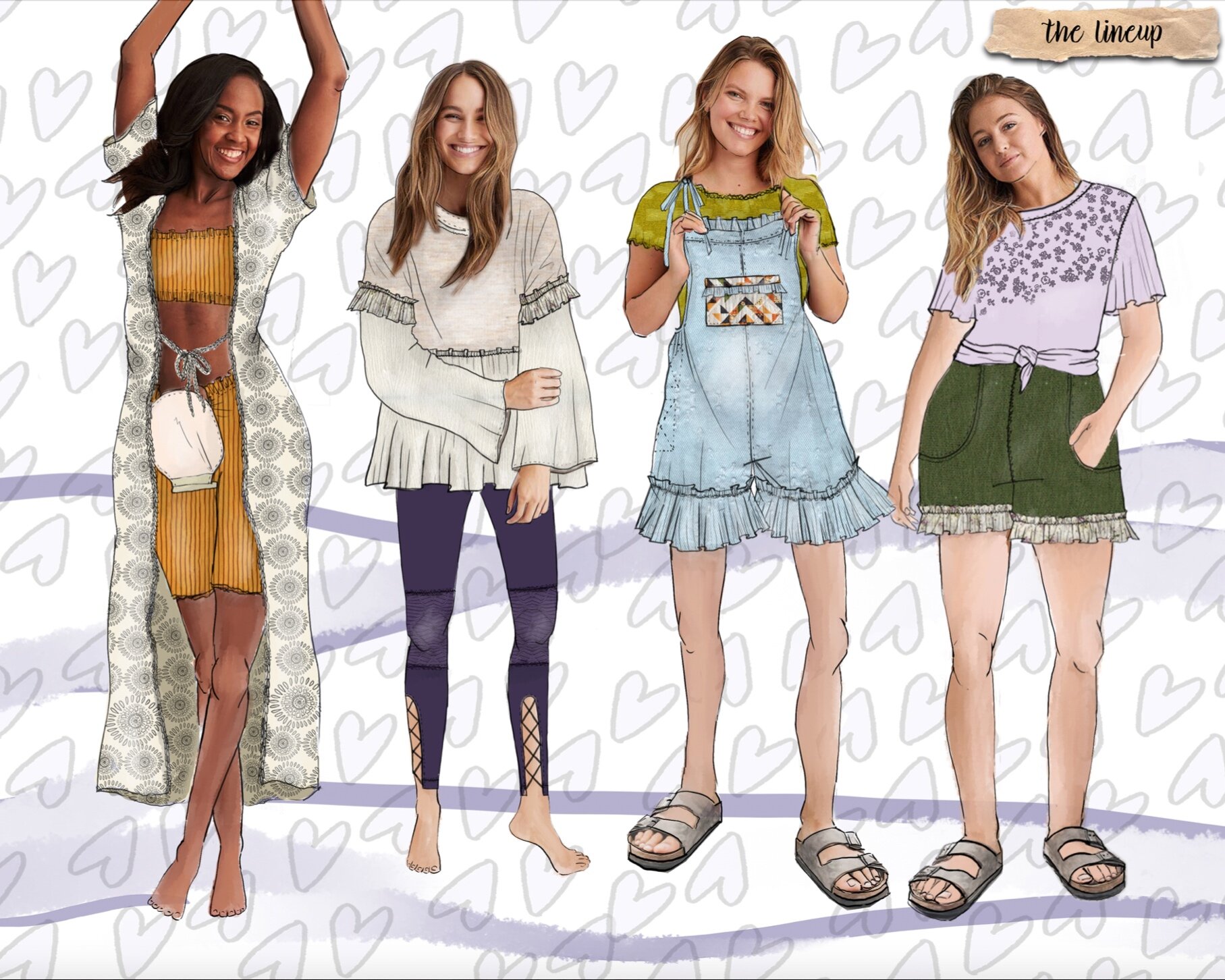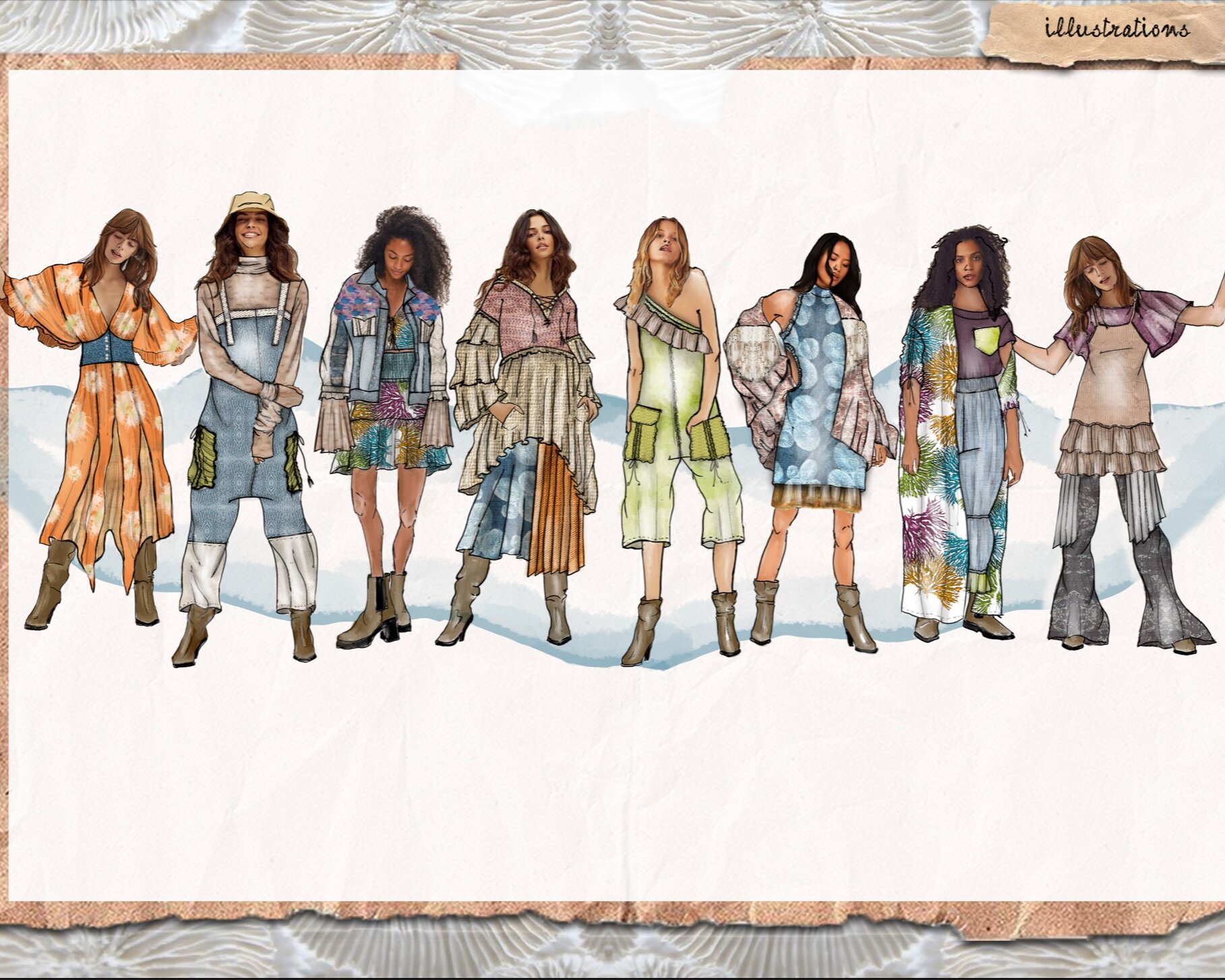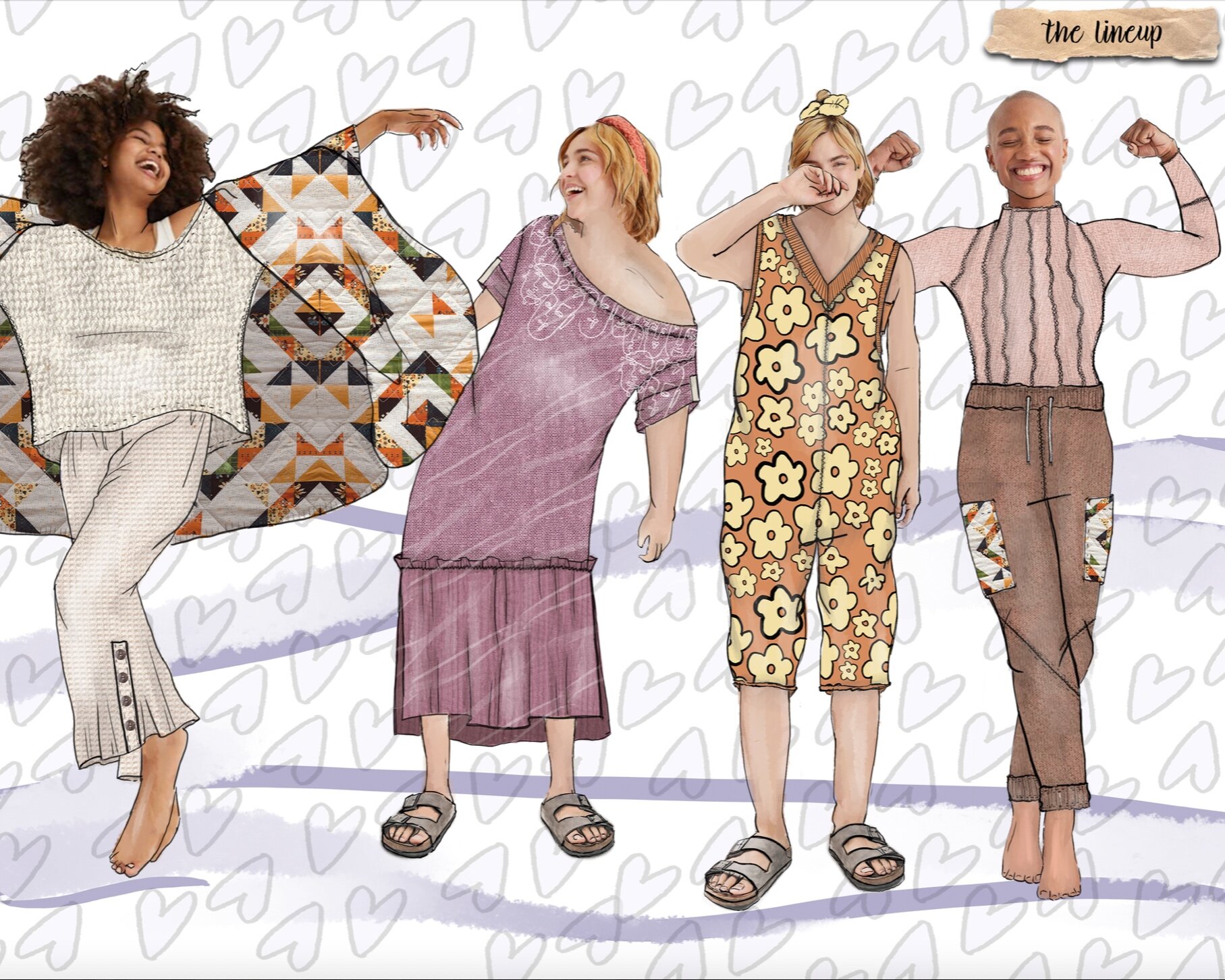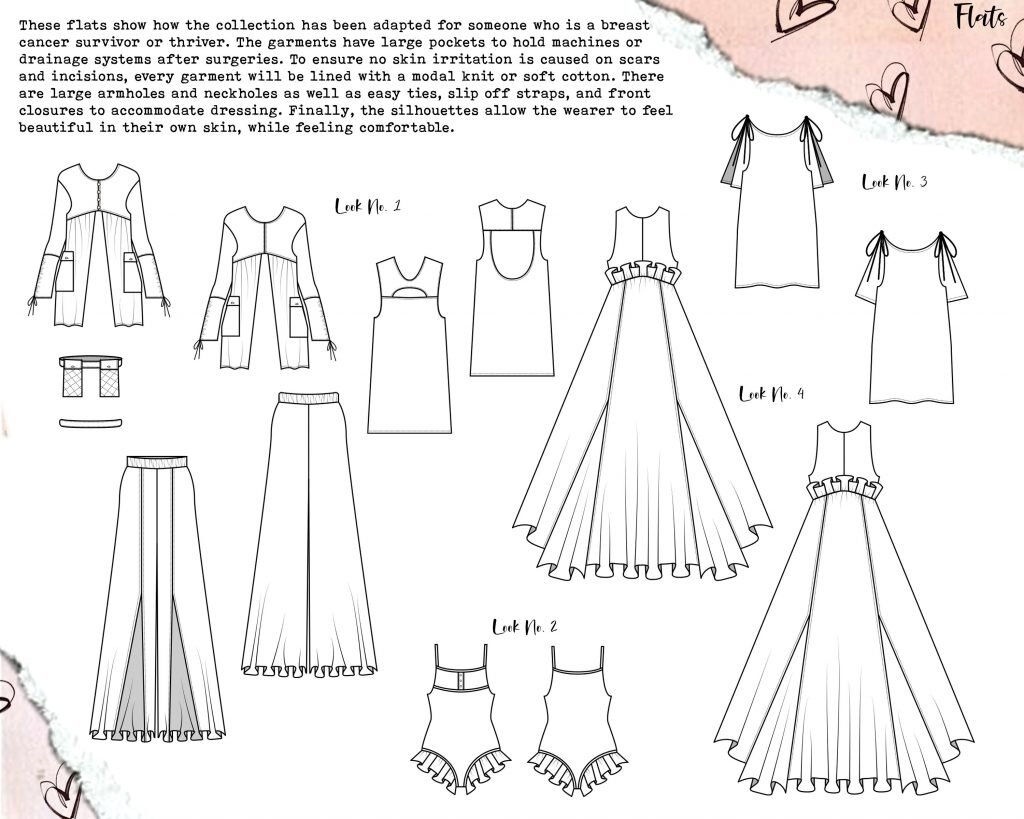Girl Talk: The Future Of Adaptive Fashion
The future of adaptive fashion is bright. Don’t believe me? Well, maybe you’ll believe Mckenzi Migliorini. She is a senior in college studying fashion design preparing to take the industry by storm. She believes that fashion can be fashionable and functional for people of all abilities. During our conversation we discussed her education, design process, and the present and future state of adaptive fashion.
JILLIAN: Start by telling me a little bit about yourself.
MCKENZI: My name is Mckenzi Migliorini. I am currently a senior studying fashion design student at Jefferson University. I am from Stafford, Virginia but right now am living in Philadelphia, Pennsylvania. I also work part-time at Free People as a design assistant.
JILLIAN: Where did your interest in fashion start?
MCKENZI: As a kid I always wanted to do something creative. At first, I aspired to be an artist or a photographer or baking, creating something for someone else. At the same time I always loved to dress up as a kid. My mom would let me dress myself at a very young age, though thanks to her for giving me this independence, I did not always have the cutest looks. Looking back, I feel like I always had an interest in fashion. I would dress up my dolls, have them walk down a runway, all the girly things you did as a child. It was in high school that I knew I had to hone in on what I actually wanted to do. I had a friend introduce me to this small sewing school, which was shocking to find in such a small town, and I enrolled. I was timid at first. I did not know anything about sewing and knew no one who could sew or was interested in making their own clothes. But, once I started, I never looked back. I remember making my first straight skirt, sewing all the seams up, and wearing it to school and I knew that this was what I wanted to do. Throughout high school I kept creating and building up my portfolio. Knowing that numbers and business was not for me, I applied to college planning to fashion design. I knew that having a more trade-based college experience would be a really good fit for me.
JILLIAN: How would you describe your design aesthetic?
MCKENZI: There is always a narrative in the clothes that I design. I love to tell a story. I love concept development. My work is usually inspired by the people that I know, such as my family, or by a message that I want to be spread. I love spreading awareness through my garments in an abstract way. It allows me to educate the consumer and it gives more interest in the story and the narrative that I am telling. For me, it is all about making an impact.
The adjectives I would use to describe my design aesthetic are purposeful, soulful, handspun, handcrafted. I am really into handdone details. I make a lot of my own fabric textures and manipulations. My looks and garments definitely have a more bohemian vibe and a good marriage between femininity and masculinity, all depending on the consumer I’m designing for. I would say that I am really inspired by the world around me. I feel like we, as humans, are sponges. We absorb everything around us without realizing it. I love the idea of walking around in your day to day life, seeing somebody wearing something cool or seeing something striking in nature, and thinking of what I could create. For example, I could develop a new, inventive dye technique with flowers and see what colors I can discover. I design clothes that are experimental, bohemian, and very functional. Whatever garment I’m making is something that is going to be easy to wear, have purposeful design features, and is going to fit really well on the consumer.
JILLIAN: Love that. I think function is so key in fashion design.
Who are your fashion inspirations? Where do you draw inspiration from?
MCKENZI: This is always a hard question to answer. I really love the brand Ace & Jig. They feature sustainability at their core and they have really interesting textiles that they mix and match together along with innovative silhouettes. The way that they style their garments is very out of the ordinary. I would say that their use of print and pattern and their story at the heart of the company is very inspirational to me.
I also get a lot of inspiration from Instagram and social media. I follow a lot of off-the-grid influencers and bloggers. I find what the micro-influencers are doing really interesting as they are not always the most famous but they have a more street style and are moving to the beat of their own drum.
JILLIAN: What sparked your interest in adaptive fashion?
MCKENZI: When I started college, I was really confused about what I wanted to do in fashion. At first, I fell in love with children’s wear. I concentrated on that during my freshman and the beginning of my sophomore year. But, I felt like there was something more I could be doing. I felt like I was being called to do this profession and that there was a purpose for me to become a fashion designer. I found out about this not so niche market of people with disabilities. I say not so niche because, after all, 1 in 5 of people in America are differently abled. As I found out more about adaptive fashion, I observed that people in my life that were differently abled or had limitations with getting dressed or finding garments while they were out shopping. I would say those struggles along with listening to TED Talks and hearing differently abled people tell their story was what really sparked my interest.
Furthermore, I was intrigued by the whole idea of inclusivity and the fact that, from a design perspective, it is a challenge. You are constantly asking yourself how many different ways can you benefit someone else: What closure can you use instead of a zipper? Magnets? Velcro? Where are you placing closures? What is the easiest solution for someone who is seated versus someone who has a prosthetic?
The need for adaptive fashion is very important and can be very lucrative. I felt that the differently abled population was not being heard and I wanted to fill that void in the design space.
JILLIAN: I love that.
Did your school offer adaptive fashion courses to take? Did your professors teach you how to design adaptive wear? Or, did you have to teach yourself?
MCKENZI: I definitely had to teach myself. I have done numerous projects about adaptive wear and really did the work to get the details exactly right. There was one instance where in a portfolio class my senior year we did have the opportunity to design an underserved market collection. I chose to design for the differently-abled consumer and focused on people who were seated individuals or who had prosthetics and needed clothing with different closures. It has definitely been mostly my own learning and research. I spent countless hours talking to people, watching videos on people’s day-to-day lives. This conversation is also a very good example of what I’ve been doing over the past few years, trying to recognize this consumer and learn more and design better for them. I’m not perfect when it comes to designing adaptive wear so the more knowledge I can gain, the better. It’s not necessarily the school’s fault. I would say that the light is just being shone on this issue of adaptive fashion and inclusivity. I would say now more than ever, perhaps because of the global pandemic, a lot of voices have been amplified because a lot of people have had the time to advocate and sit down and have conversations like this. I would say it is going to get better within the university. I think the future of fashion definitely rests in its students and you have to cultivate this environment where people can create more inclusive fashion. But, it definitely was not in my curriculum. I made it a part of my curriculum based on the consumer that I chose to design for.
JILLIAN: That’s amazing. I’m not surprised, even though adaptive fashion has really come onto the scene over these past few years, that there still are not any classes offered for students like you to learn about adaptive fashion, even the basics.
MCKENZI: From what I’ve experienced at the university, it takes a long time to get the ball rolling. The thing is there is not a lot of education available. Remember, they have to find someone to teach this material. When I worked on that project, my professor was educating me, but it was also a learning experience for the both of us. I think that integrating adaptive fashion within a course is a great step in the right direction. It really got me and my peers thinking about how we can design for this consumer in the future.
JILLIAN: You said that when you were working with your professor on your portfolio that it was very much a collaborative effort where you were both learning together. But, have you met any resistance, whether it is from your peers, professors, or anyone within your community, when you said you wanted to pursue adaptive fashion?
MCKENZI: I would say no, there has definitely been no resistance. Rather, I’ve received a lot of encouragement. That being said, I have definitely encountered people who are uneducated as to what adaptive fashion is, which is totally fine, I’ve even had people at my job ask questions. I will be asked what adaptive fashion is, to define it, and how my garments are created because a lot of people do not understand what designing adaptive fashion entails. Because there is not a lot of knowledge readily available, I have the ability and the privilege to spread that information and a lot of people are willing to listen.
JILLIAN: You brought up defining adaptive fashion. How do you define adaptive fashion?
MCKENZI: I’ve found adaptive fashion challenging to define because there are so many differently-abled individuals who have different life journeys, adversities, and experiences, and it is very hard to include them all when designing. The biggest struggle that I’ve faced is picking a consumer and designing for them while also keeping in mind the population at large.
The best definition I can come up with is that adaptive fashion is an innovative way of thinking and designing clothes for individuals who are underserved and not heard in the fashion industry. It involves creating different closures and finding different ways of constructing a garment. But, it can be clothing that is desired by people with all abilities, not just those that are differently-abled. I believe that adaptive fashion needs to be functional, but it can also be beautiful and aesthetically pleasing and I’ve proven that in the garments that I’ve created.
JILLIAN: I 100% agree. I’ve said it to you before and I’ll say it again here that I see your Instagram stories and will DM you asking for your garments in my size, please. I am obsessed.
When you sit down to sketch a garment, what is your design process?
MCKENZI: Before I even start sketching I create a concept or narrative in mind. I utilize visuals and imagery, I have a sketchbook full of ideas. From there, especially when designing adaptive fashion, I do a lot of research on closures and different silhouettes that work best for the consumer that I am designing for, compiling as many visuals as I can find. Having those visuals are very helpful as I’m designing.
Once I nail down a narrative and gather visuals, I’ll grab my sketchbook and start sketching on top of my croquis. I’ll design a bunch of clothes, around 30 sketches or so, and then pare down from there depending on if I am designing an individual outfit or a collection. For me, the more ideas I can get on paper, no matter how rough, the better. Sometimes I’ll morph sketches together to create a look. After I’ve honed in on my ideas I’ll plug in fabrics and create a merchandising plan. Sometimes I’ll do the final sketches at the end, or I’ll make the garment and then complete the final sketches.
JILLIAN: That’s amazing. I love that you start with so many ideas and then work to create one, complete vision.
You said before that you’ve taught yourself how to design adaptive fashion. What would you say are the biggest challenges you’ve faced and how have you overcome them?
MCKENZI: One of the biggest challenges that I face is not being a differently-abled individual. I get a lot of my most valuable information by learning from others. But, at the same time, I am not the one who lives that life day after day.
There is also a lack of information. I have dived to the deep depths of the internet to try and find out as much as I possibly can. I have word documents on top of word documents with links, videos, stories, and commentaries about adaptive fashion. It is all amazing but I definitely feel there needs to be more. There is so much information available about how to construct garments for all abilities, but there is not a lot of information about how to construct garments in regards to adaptive wear.
However, the idea of creating a beautiful garment that is also desirable and wearable by people with all abilities is being discussed within the fashion industry. I sat in a chat with Tommy Hilfiger and he was talking about how he wants to create garments for all abilities and not single out a consumer. He wants his clothes to be desired by all which I feel is super important. I believe that creating something that is both functional in an adaptive sense and functional for individuals with all abilities would help decrease the gap between these two groups of people. People want clothes that are beautiful and functional.
At the same time, from a business perspective, I think the fashion industry is having a hard time justifying the money and the finances, forgetting that if you create something that is wanted by all abilities then you don’t have to worry about that. The money will make itself.
JILLIAN: That’s a very good point. I think that Tommy Hilfiger is one of the brands that is really doing it right. Their adaptive line, Tommy Adaptive, still looks like Tommy Hilfiger. The clothes look like they are designed for a Tommy Hilfiger customer, but they are adaptive so people with different disabilities can wear them. That is the example that needs to be followed. Other designers and labels need to see this and say it’s possible. Moreover, in regards to the money, people with disabilities comprise the largest minority in the world, so there is a market for adaptive wear.
MCKENZI: Yes, the market definitely exists. In regards to Tommy Hilfiger, I believe they hit the nail on the head. They first honed in on a few garments and made them perfect before expanding because progress takes a long time. What Tommy Hilfiger did was hone in one or two garments, like his jeans for example, and said they wanted to make those perfect, re-designing them to be adaptive while maintaining the brand’s identity. There is no reason why other brands can’t follow his example. Plus, the solutions are simple. Perhaps it is finding a different fabrication or adding magnetic or velcro details. There is not a lot that needs to be done in order to make a garment adaptive. I am so looking forward to the future to see how the industry develops new, innovative techniques to make adaptive clothing.
JILLIAN: I love that.
Speaking of the future, because you are a senior, what is the next step for you? What are your goals and aspirations? Do you have a plan post-graduation?
MCKENZI: I am about to graduate which is very exciting. Right now it is very challenging to find a job within the adaptive design space, which I’m okay with at the moment. I definitely want to learn more about the industry and to get my feet wet right after college. But, I plan on working and spreading awareness about adaptive clothing, whether it’s for my job or my side hustle. Adaptive design is so new in the industry and a lot of brands are still trying to figure out how to integrate adaptive wear within their deliveries and line plans.
My overall goals and aspirations are to design accessible clothing in the future, whether it is for people who are differently-abled or people with all abilities. I want to keep spreading awareness about the need for inclusivity within the fashion industry. My long term goal is to become a fashion designer that integrates adaptive features into the clothes that I’m making.
JILLIAN: I am so excited for you.
You touched on the fact that, right now, there are not many positions available for people to design adaptive wear. Do you think that brands are not ready to enter that market or that they do not know how?
MCKENZI: I would say both. It is my own personal opinion that a lot of businesses and retailers within the industry do not understand where to start and they are not educated on how to create adaptive wear. From a financial standpoint, a lot of companies are probably holding back, which they shouldn’t. Like I said before, if you create a garment that is beautiful and functional for everyone, then everyone will buy it. It is taking a longer time because companies are trying to navigate making adaptive clothing while maintaining their brand. That being said, based on conversations I’ve had with certain companies, adaptive wear is in their future plans which is very exciting.
Moreover, we always have to consider the design calendar. Designers are designing clothes a year in advance. If we are getting specific information now, it is very hard to integrate it into garments that are coming out next month. Rather, we may not be seeing adaptive garments until a year from now. It is unfortunate but it is also reassuring to know that we are thinking about it now.
JILLIAN: I knew about the fashion calendar, but never really considered it. It is so key to remember that designers today are creating their collections for the fall.
When I first approached you and we discussed ideas about how we could collaborate, what were your first thoughts about designing for a little person? I do feel like that little people are still not included in the adaptive fashion conversation so, as a design student interested in adaptive wear, what were your initial thoughts?
MCKENZI: I was stoked. I definitely believe it can be done. I think that the key to designing for a little person is in pattern-making. First, I have to understand what best suits you as a consumer and what you desire. The first questions I asked you were “What kind of garments do you like best? What silhouettes work best on you? What neckline do you prefer?” After that comes the pattern-making, the first initial production processes, and creating samples. It may take a few tries to get the fit perfect, but that happens when creating any garment. You have to find that pattern that fits better, that conforms more with your measurements. You can construct a pattern from scratch- all you need is a paper, a ruler, and a pencil. It is not anything out of the ordinary. People who are educated in pattern-making and draping can definitely be the ones to change the market for a little person.
JILLIAN: Do you hear that fashion industry? It can be done. That was an amazing answer and I am very excited to continue with our collaboration.
Outside of the fashion industry, who do you look up to?
MCKENZI: I look up to the people in my family. They ground me. I am very much a hometown girl at heart. I always revert back to my roots when designing. They are who I go to when I need advice about life and making sure that I am following the right path and that I am being purposeful with the choices that I’m making. My dad taught me, as cliché as it sounds, that hard work pays off. He has always encouraged me to follow my dreams and what I believe in and to pursue a passion that I would want to do for work every day. He always found that to be really important within life and he definitely instilled that within me.
My brother found his passion, baseball, and works hard for it. He has taught me how to find something you love and to integrate it into what you do.
My mom just serves and loves others so well. I definitely got my interest in adaptive fashion from her and how she practices the idea of loving your neighbor. It is because of her that I am making clothing with a purpose and with a function, not just to be beautiful.
JILLIAN: I love that so much.
Are there any questions that I have not asked that you would like to answer?
MCKENZI: I don’t think so. I feel like we covered the topic of adaptive fashion really thoroughly.
JILLIAN: I agree. That is a totally acceptable answer.
Final question. I’m assuming that as someone who loves fashion that you have watched Project Runway.
MCKENZI: Yes.
JILLIAN: What would be your dream unconventional materials challenge and what would you make?
MCKENZI: This is a hard question. Well, because I’ve actually done a few of these challenges in the past for schools and for a museum program I feel I’ve gotten a handle on how to work with unconventional materials. I feel like my dream challenge would be to walk into a candy store and to design from whatever you find inside. You could use the wrappers and manipulate them into these weird shapes. I feel like I would make this beautiful ball gown out of all of these candies where the top is a corset and I would create a cool texture using peppermints and gumballs and the bottom part would be made out of the bags that you get all the candies in. I would tape them all down to make this crazy train and, instead of a cape reveal, have a skirt reveal where the underneath has all this texture and floral wrappers all along the bottom. Also, who doesn’t love candy? I would eat it while I create. That would be amazing.
JILLIAN: OMG. I am putting it on the record that my jaw just dropped. Project Runway season 19, get her number.
I am so thankful to mckenzi for taking the time to speak with me and so excited to see the impact she makes on the fashion industry. the future of fashion is adaptable. the future of fashion is accessible. the future of fashion is inclusive for all.
Follow Mckenzi:
Portfolio: Mckenzi Migliorini
Social Media Handles:
INSTAGRAM: @kenzi_miggs
TWITTER: @KenziMiggs










